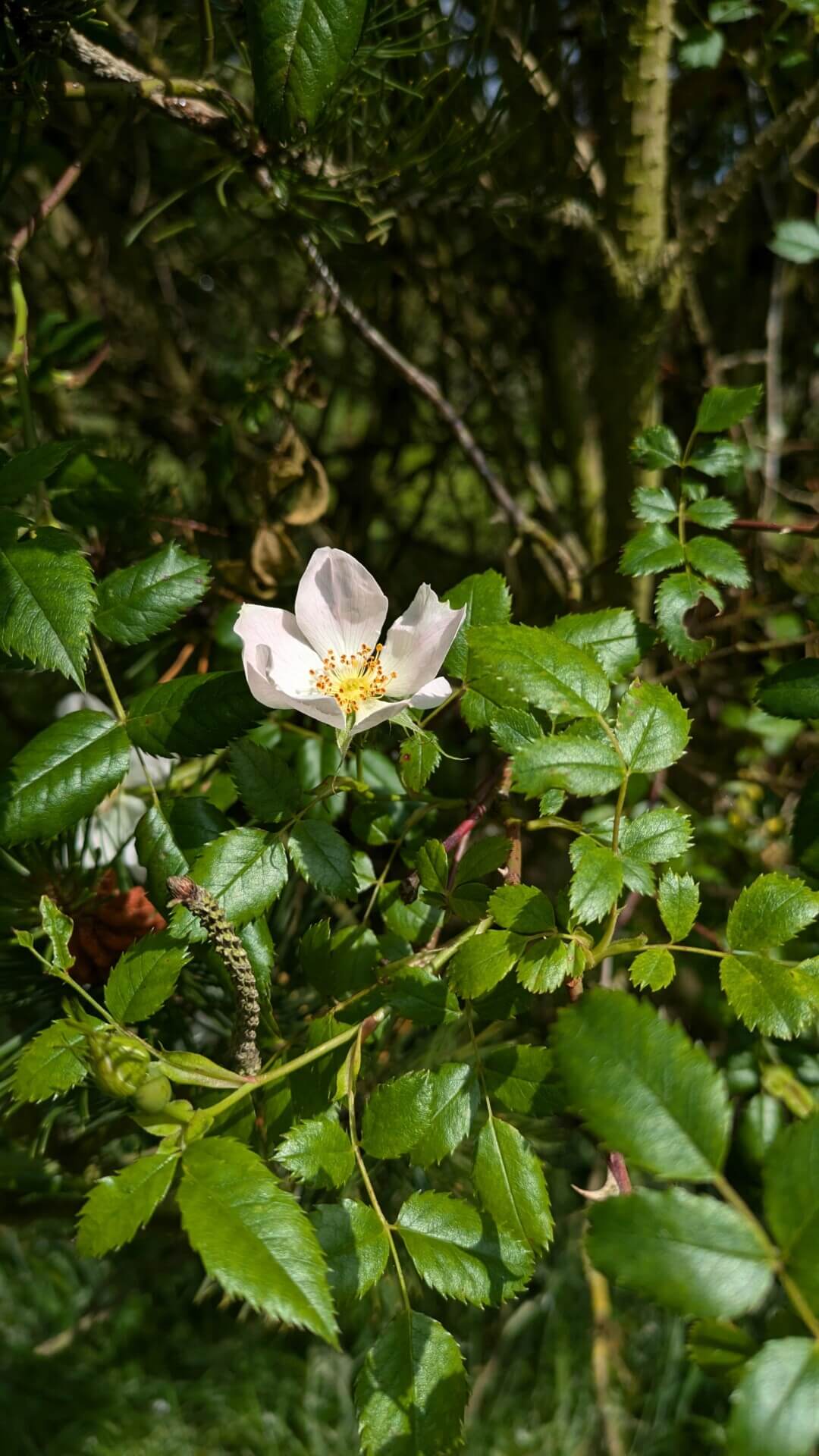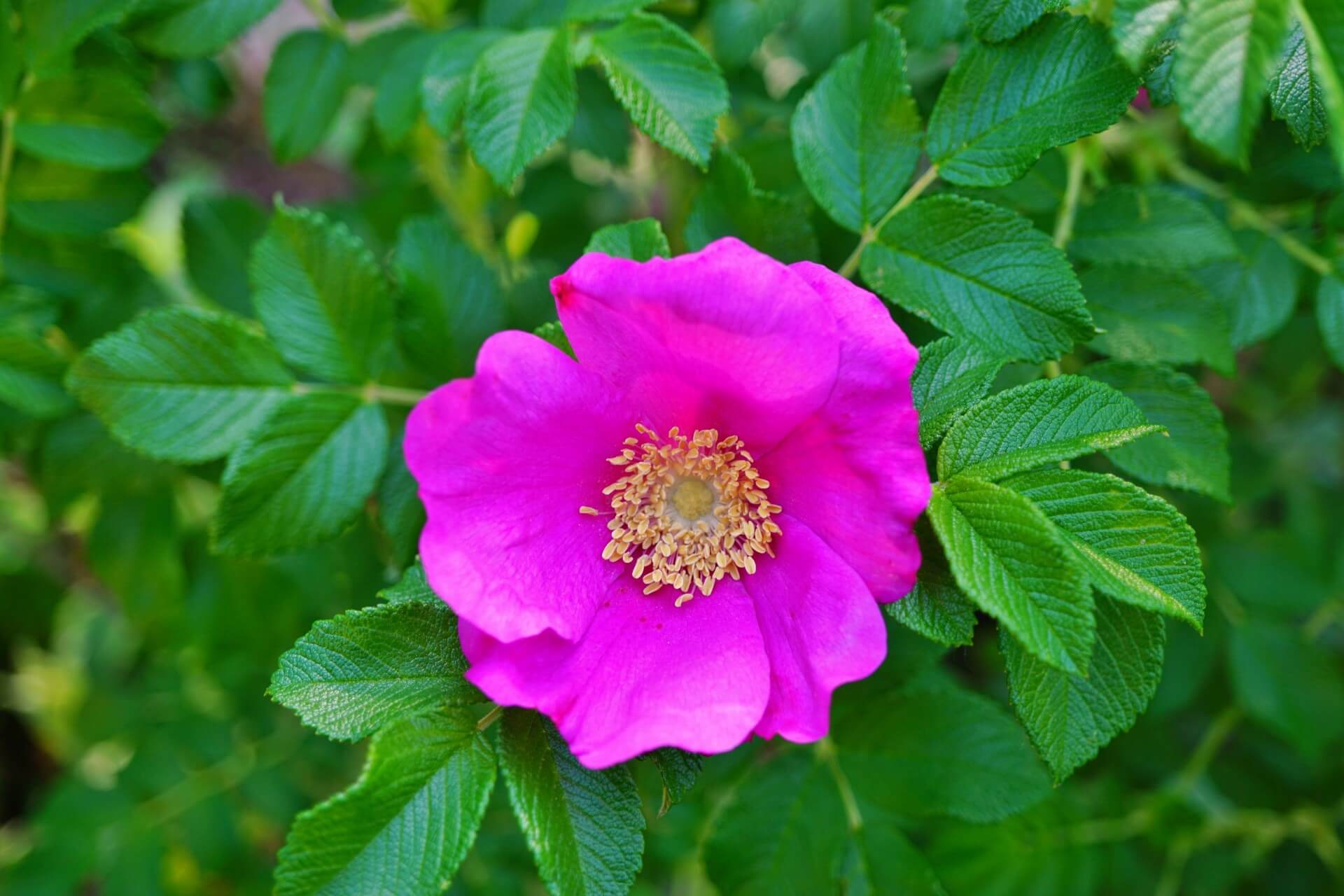What Is Dog Rose?
The dog rose (Rosa canina) is a species of wild rose native to Europe, northwest Africa, and western Asia. It’s a climbing shrub known for its arching stems and thorny branches. The dog rose produces pink flowers in late spring and early summer, followed by bright red fruit called rose hips in autumn.
The benefits to wildlife
Dog Rose holds significant value for wildlife due to its various ecological contributions. Its delicate flowers attract pollinators like bees, playing a crucial role in the ecosystem by aiding in pollination.
As the seasons change, the plant’s rose hips provide a rich and reliable food source, particularly during the harsh winter months when resources are scarce. Birds, such as thrushes and blackbirds, rely on the nutrient-packed rose hips, while small mammals also benefit from the extra food.

How To Identify Dog Rose
The Leaves
The leaves are divided into 5–7 small oval leaflets with finely toothed edges. They are glossy green on top and pale with a slight fuzz underneath.
The Flower
Simple with five petals, and they have a delicate, subtle fragrance. They are typically pale pink, though they can range from white to deep pink.
The Fruit/seeds
The fruit, known as rose hips, are oval or round and bright orange-red when ripe, appearing in late summer through autumn. Inside, they contain small, hairy seeds. The hips are a rich source of Vitamin C and the hairy seeds can be used to make itching powder.
Hazards To Be Aware Of
For a secure foraging experience, adhere to the precise guidelines for identifying Dog Rose. Some plant species may exhibit a similar appearance, especially at various stages of development.

Japanese Rose
Japanese rose (Rosa rugosa) hips are generally safe for consumption in small amounts, as they are often used in jams and syrups. However, caution is advised because:
Potential Allergies: Some individuals might experience allergic reactions when consuming rose hips, especially if they have sensitivities to similar plants.
Irritating Seeds: The seeds inside the hips can cause irritation to the digestive tract if not properly removed.
Pesticides or Contaminants: They may have been sprayed with chemicals not safe for ingestion.
How To Locate dog rose
- Habitat: Look in hedgerows, woodlands, scrublands, and along roadsides or field edges. Dog rose thrives in sunny or partially shaded areas with well-drained soil.
- Season: Look for pink or pale white flowers, typically blooming between June and July. Bright red-orange rose hips appear from late summer into autumn.
- Growth Pattern: Dog rose is a climbing shrub with arching stems that often scramble over other plants or structures.
- Leaves: Its pinnate leaves with 5–7 toothed leaflets can help identify the plant even when not in flower or fruit.
- Thorns: The stems are covered in curved, sharp thorns, making it easy to spot up close.
By focusing on these characteristics and exploring suitable habitats, you’ll have a good chance of locating dog rose.
Dog Rose can be found in the Heritage Room of the arboretum at Burton Constable Holiday Park. You can read more about arboretum here.
uses of Dog Rose
Rose hips (the fruit of the dog rose) have numerous uses, particularly for their medicinal, culinary, and beauty benefits. Here are some common uses:
Health and Medicinal Uses
Vitamin C: Rose hips are rich in vitamin C, making them a popular natural remedy for boosting the immune system and fighting colds.
Anti-inflammatory: They have anti-inflammatory properties and are sometimes used to help with conditions like arthritis and joint pain.
Digestive Health: Rose hips are used to aid digestion, as they can have mild laxative effects.
Rose Hip Syrup
Often made by boiling the rose hips with sugar and water, this syrup is a traditional remedy for colds and coughs. It can also be used as a sweetener or flavouring for desserts and drinks.
Rose Hip Syrup and the Second World War
During World War II, rose hip syrup became crucial in Britain as a source of vitamin C, especially during food rationing. With limited access to fresh produce, the government launched a “Rose Hip Campaign” encouraging people to gather wild rose hips, which were then turned into syrup. This syrup helped prevent scurvy, particularly in children, and was distributed in schools as part of daily rations.
Rose Hip Tea:
Dried rose hips are often used to make a tangy, fruity herbal tea, known for its immune-boosting properties.
Jam and Jelly:
Rose hips can be used to make jams, jellies, and preserves, thanks to their natural pectin content.
Cosmetic and Skin Care:
Rose Hip Oil: Extracted from the seeds of the hips, rose hip oil is known for its hydrating and anti-aging properties. It’s used in skincare for its ability to reduce scars, fine lines, and promote skin regeneration.
Rose Hip Seed Powder: Used in some beauty products for exfoliating and brightening the skin.
Culinary Uses:
Sauces and Purees: Rose hips can be turned into sauces, purees, or even included in savoury dishes for a tangy kick.
Baked Goods: Rose hips can be added to baked goods, like muffins or cakes, for extra flavour and nutrition.
Natural Dye
The bright red or orange color of rose hips can be used as a natural dye for fabrics and textiles.



